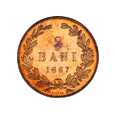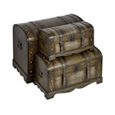“Pipiri” dress with “gold” and “silver” thread
Text: Roxana Gâscă, Cornel-Constantin Ilie; foto: Marius Amarie
The dress of the “pipiri” type is encountered, at the end of the 18th century and in the 20th century in the entire Balkan area, at Serbians, Greeks, Albanians and Romanians. Similar models to the one in the collection of the National Museum of Romanian History are also found in the patrimony of the Metropolitan Museum in New York. It is obvious that garments like this could belong only to some high society ladies or young ladies. In the cards accompanying some of the models at MET, it is said they are wedding dresses, which is plausible given the fact they are so sumptuous and expensive. The three “pipiri” dresses in the collection of NMRH are in a very good state of conservation (especially the two dresses that are entirely covered in “gold” and “silver”), which shows that they have been very little worn (maybe only at the wedding!). Moreover, their very small sizes may lead to the idea of wedding dresses (or engagement dresses), as it is known that, in the above mentioned time, girls used to get engaged or married at very young ages (when they were 14, 15 or 16 years old). The dresses could have been imported from abroad, but it is also likely they have been locally made, especially if we take into consideration that one of the dresses still has on the inside the paper pattern on which the model of the ornamentation has been sewn.
The copper thread used for making the ornaments is “covered” in gold and silver, the physical and chemical analyses showing different concentrations of the precious metal at the three “pipiri” dresses presented here.
The “pipiri” dress with the inventory number 53057 is made of black cloth with a bias cut and wide hems, slightly tight on the waist, without sleeves and with front opening. Both its front side and its back side are richly embroidered with golden thread, with typically Oriental ornamental motifs: floral elements and a half-moon, above which there is a star with eight rays. The edge has a wide border embroidered with thread, straight at the sleeves, on the back and at the waist, and spiraled in the rest of the dress – in the front, on the hems and around the neck. It is lined with Bordeaux cloth.
The chemical composition of the golden thread:
Border: Cu 81.35%, Ag 16.81%, Au 1.75%, Fe 0.06%, Pb 0.02%
Ornaments: Cu 74.67%, Ag 22.95%, Au 2.76%, Fe 0.53%, Pb 0.04%, Ni 0.05%
The dress with the inventory number 142139 is entirely made with golden and silver thread; it is bell-shaped, slightly tight above the waist, with a front opening and wide hems. The golden and silver thread embroidery is applied on purple velvet; it is very rich and covers the entire front side of the dress with typically Oriental ornamental motifs. On the edges, next to the slits for the arms and on the back (close to the waist) it has bands – one sewn with silver thread and one made from a golden silk band; in the middle of the back, a gilded thread rich embroidery is sewn. On the hems, on the back side, a silver and golden thread embroidery is sewn; below it, slightly obliquely, a band made of silver thread alternates with two bands of golden silk, between which there is a band sewn with gold thread. On the back, the paper on which the pattern was sewn is still preserved.
The chemical composition of the thread:
The “gold” thread: Cu 97.77%, Ag 1.24%, Au 1%, Fe 0.10%
The “silver” thread: Cu 90.12%, Ag 9.81%, Fe 0.05%, Pb 0.02%
The thread in the silk band: Cu 90.61%, Ag 8.02%, Au aprox. 1%, Pb 0.27%, Fe 0.19%
The dress with the inventory number 147402 is very similar to the previous one, but it is much tighter, with wider hems and slit sleeves. The ornamentation made with gilded and silver thread is sewn on Bordeaux velvet. Beneath, it has a striped cotton lining. In front, it has 18 buttons made of thread and decorated with 5 coral beads each. The sleeves have 10 buttons with a coral bead each.
The chemical composition of the thread is the same as in the case of the previous dress. The buttons have revealed the following values: Cu 97.48%, Ag 1.70%, Au 0.73%, Fe 0.06%, Zr 0.03%.
Aspects regarding fashion in the Romanian Principalities at the end of the 18th century and the beginning of the 19th century
The Turkish outfit had been long known in the Romanian Principalities because the Romanians were visibly influenced by the Ottoman lifestyle. They took various dishes, garments and accessories, as well as leisure activities, which later implied drinking coffee and going to cafés.
During the Phanariotes’ epoch, nothing new was imposed in fashion; on the contrary, it was officially forbidden to introduce any European item in the Oriental clothing.
The reign of Nicholas Mavrocordatos proved that, excepting some insignificant changes regarding some jewels or even garments, the Romanian clothing in both Principalities had undergone no obvious modifications until 1750, remaining faithful to the style in Constantinople, as a continuer of the fashion under Brâncoveanu.
Both in the descriptions in the chronicles or in the foreign travelers’ notes and in the documents, referring here to dowry papers, as well as in the plastic representations of rulers, high officials and not only, we can notice an abundance of mantles (“caftans”), dolmans, fur caps (“ishliks”), hooded robes (“ipingele’), silk mantles (“feregele”) etc., all of high quality and, obviously, decorated with luxurious furs and the most exquisite jewels.
Willing to show their social status, the Romanian boyars managed to exceed in luxury even the Ottoman high officials. It was a real fashion competition in wearing jubbahs, fur caps (“ishliks”), surplices, waistcoats (“cepkens”), shalwars, Turkish embroidered vests (“fermenele”), made of the best fabrics brought from all over the world, some hemmed with fur or decorated with gold or silver thread and the most precious gems. It can be noticed that the sable fur brought from Siberia is abundantly used on the hems, collars and sleeves of the clothes. Likewise, fine silk was introduced into the clothing of the Romanian boyars, as a sign of nobility.
In a letter to his sister, John B. Sawrey Morritt, a young rich English traveler, who, on his way to Constantinople, crossed the Carpathians from Transylvania into Wallachia, described a lady from the Phanariote Wallachian elite, offering an insight into the fashion of the late 18th century. In his description, Morritt highlights the hospitality of the Wallachian lady, the wife of an aga, who welcomed him and his two young travelling companions, as well as the Oriental clothing she was wearing. Morritt wrote that this picture of a domestic exoticism, marked by the colorful outfit, was completed the next morning by an unusual – for a Westerner – Turkish breakfast with coffee and rose sherbet.
The letter to his sister is dated the 25th of July 1794 and is, actually, an analysis of the outfit worn by the lady, among other things.
“She was sitting on a low sofa which covered half of the room, surrounded by 5 or 6 servants. (…) Her dress had long sleeves and a deep cleavage and it was pinned (…), pinned around the ankles (…) like the trousers, and it was made of multi-colored muslin. On her head, she was wearing a flat bonnet with a golden tassel on top and a shawl fastened below the bonnet, allowing her hair to wave on her shoulders. Over the dress she was wearing a long, dark blue mantle, lined with fur, with three quarter sleeves. She used to wear both yellow leather boots and slippers, which were left beside the sofa, because all of them were sitting with their legs folded, à la Turque. Over her breast, she was wearing a thin layer of muslin, tightly fastened below the chest. Although she wasn’t very young, I can assure you it is very difficult to imagine a more elegant presence than hers”.


















